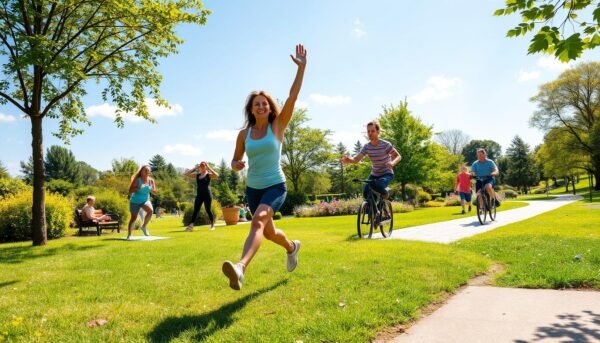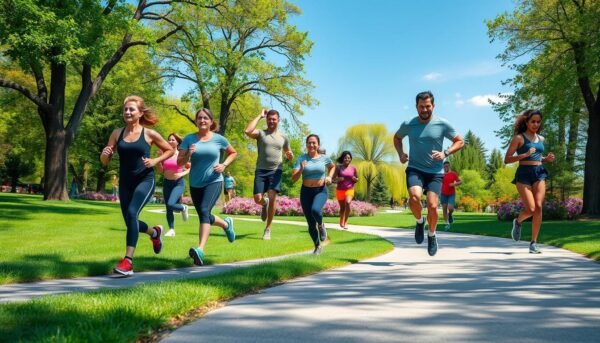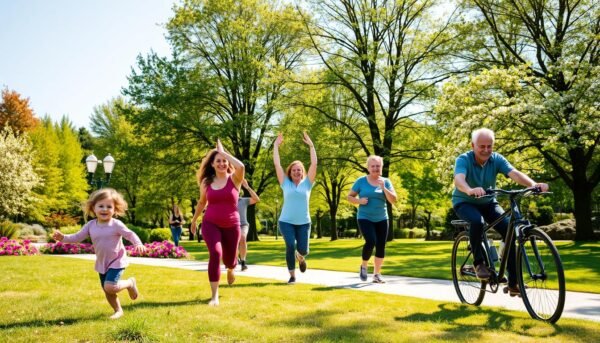As I lace up my sneakers and step out into the crisp morning air, I feel excited. My daily exercise is more than staying fit. It’s key to living longer and healthier. Studies show that regular exercise can lower death risk and add years to life.
Finding the right mix of exercise is important. A study in Circulation found that 300 to 599 minutes of moderate activity weekly lowers death risk by 26% to 31%. Vigorous exercise for 150 to 299 minutes weekly cuts death risk by 21% to 23%.
Exercise benefits don’t stop there. A study in JAMA Oncology found that vigorous activity lowers cancer risk. For older adults, vigorous exercise improves health, as another study showed.
So, adding years to your life or feeling youthful is possible. The right mix of exercise is the key. It’s time to start your journey towards a longer, healthier life.
Benefits of Regular Physical Activity
Reduced Mortality Risk
Regular physical activity is a powerful tool in reducing mortality risk. People who are active have a 30% to 35% lower risk of dying from any cause. This means they can live 3.5 to 4 years longer than those who are not active.
Being inactive is a big risk for death, causing up to 10% of deaths in Europe. But, regular exercise can lower the risk of death from many diseases. This includes heart disease, stroke, and cancer.
Being active can lower your risk of death by 20% to 35%. By making exercise a priority, you can live longer and feel better overall.

Optimal Levels for Longevity
Being active is key to living longer. Studies show that the right amount of exercise can add years to your life. People who are active live 0.4 to 6.9 years longer than those who are not.
Those who are most active live the longest. They do moderate to high-intensity activities. Here’s what you need to know about staying active:
- Moderate Aerobic Activity: At least 150-300 minutes per week
- Vigorous Aerobic Activity: 75-150 minutes per week
- Optimal for Maximal Longevity Benefits: 700 minutes of moderate or 350 minutes of vigorous physical activity per week
Strength training also helps a lot. It can lower the risk of dying from any cause and heart disease. Aim for 60 minutes of strength training each week.
| Activity Level | Moderate Intensity | Vigorous Intensity |
|---|---|---|
| Minimal Recommendation | 150-300 minutes/week | 75-150 minutes/week |
| Optimal for Longevity | 700 minutes/week | 350 minutes/week |
| Strength Training | 60 minutes/week | |
By doing the right amount of optimal exercise for longevity, you can live longer and healthier. Remember, being consistent is important. Make exercise a part of your life for the best benefits.

Combining Moderate and Vigorous Activity
The Magic Formula
To get the most out of exercise, finding the right mix is key. The 2018 guidelines say adults should do 150 to 300 minutes of moderate exercise weekly. Or, they should do 75 to 150 minutes of vigorous activity, or a mix of both.
But, studies show doing more than the recommended can lower death risk even more. The best mix is 150 to 600 minutes of moderate activity and 75 to 300 minutes of vigorous activity. This can cut mortality risk by 35% to 42%.
This mix is vital for a balanced workout routine. It helps you live longer and healthier. The research shows combining both types of exercise gives the biggest health benefits.
To follow this mix, aim for a weekly routine that includes:
- 150 to 600 minutes of moderate physical activity
- 75 to 300 minutes of vigorous physical activity
- At least 2 sessions of muscle-strengthening activities
By finding the right balance, you’ll boost your longevity. The secret is to enjoy the activities and stick to them. That’s the magic formula for a long, healthy life.

Longevity Exercise for All Ages
Exercise is good for everyone, not just the young. It helps boost lifespan. Younger people might like intense workouts. But older adults often prefer easier activities.
Studies show that long, steady exercise is great for older, healthy adults. It’s as good as for younger people. Mixing easy and hard exercises is best for all ages.
For example, dancing for an hour is like brisk walking. Salsa dancing is like running or swimming. Weightlifting for older adults can cut death risk by 41% to 47%.
Even just lifting weights can make older adults 9% to 22% less likely to die. Simple exercises like squats help with daily tasks. Dr. Peter Attia says exercise is more important than food or sleep for living longer.
Seniors and adults should aim for a mix of strength and cardio exercises. Half should be strength training, and half cardio. Low-intensity cardio should make up 80% of workouts. Just three hours of exercise a week can cut death risk by 50%.

The Importance of Consistency
Keeping up with a regular exercise routine is crucial for a long, healthy life. Studies show that those who exercise regularly live longer than those who don’t. This is true for both light and intense workouts.
A big study with over 11,000 Finnish twins found something interesting. Those who stayed active for 45 years had a 15-23% lower risk of dying. Even when other health factors were considered, being active still lowered death risk by up to 7%.
It’s clear: staying active can help you live longer. Just 150-300 minutes of moderate exercise a week can cut your risk of dying by 19-25%. If you prefer harder workouts, you can lower death risk by 21-23%.
The trick to staying active for life is to find exercises you enjoy. It could be a daily walk, strength training, or a mix of cardio and stretching. Make exercise a habit. This way, you can enjoy a long, active life.

Intermittent Vigorous Activity Counts
Research shows that short, intense workouts can greatly improve your health and life span. A study by the University of Sydney found that three to four 1-minute intense activities can cut your risk of death by up to 40%. These activities include power walking or climbing stairs.
Short bursts of fast movement also lower heart disease risk by up to 49%. The study showed that doing three 1-minute intense activities a day can cut heart disease risk by nearly 50%. This is compared to those who didn’t do any intense activities.
Doing up to 11 intense activities a day can lower cancer and heart disease deaths by 49% and 65%, respectively. This high-intensity lifestyle is as good as regular, intense exercise, a study found. It looked at over 62,000 people.
The study used wrist trackers from the UK Biobank. It found that 89% of people did some intense activities. Most of these lasted up to 1 minute. On average, people did eight of these activities a day, for just 6 minutes.
These results show that short, intense workouts can greatly improve your health and life span. So, when you feel energetic, take a brisk walk or climb stairs. Your body and mind will be grateful.

High-Intensity Exercise Doesn’t Hurt
Recent studies show that long-term high-intensity exercise is safe for the heart. This includes activities like marathon running and triathlons. It’s also good for older adults to improve their health and live longer.
Elite runners who can run a mile in under 4 minutes might live five years longer. A study found that these runners lived longer than expected. This is based on their age, sex, birth year, and nationality.
A healthy diet and regular, intense exercise can help you live longer. Experts say exercise is key for heart health. They recommend doing moderate exercise often.
A study with over 116,000 participants showed big benefits from vigorous exercise. Doing 75-150 minutes of it each week can lower mortality rates. More exercise, even at a moderate level, also has benefits.
Vigorous exercise is better for heart diseases like coronary heart disease and stroke. It offers bigger risk reductions than moderate exercise. The goal is to do vigorous exercise when you can, then switch to moderate after 2-3 hours a week.
In summary, more exercise is good for health and longevity. It’s important to mix both high-intensity and moderate exercise. This way, you get the most benefits.

Endurance Athletes and Life Expectancy
I love fitness and always wondered about athletes’ long lives. Eleven studies looked into athletes’ life spans. They found that runners and cyclists lived longer than non-athletes.
But, not all athletes saw the same benefits. Long-distance runners and skiers lived longer and had lower death risks. Yet, other sports didn’t show the same results. This means intense training might not always mean a longer life.
It’s key to remember that these studies didn’t consider other health factors. So, while athletes might live longer, it’s not clear if intense sports add extra years. Still, being active is good for your health, especially for endurance sports fans.
This post may contain affiliate links which means I may receive a commission for purchases made through links. I will only recommend products that I have personally used! Learn more on my Private Policy page.